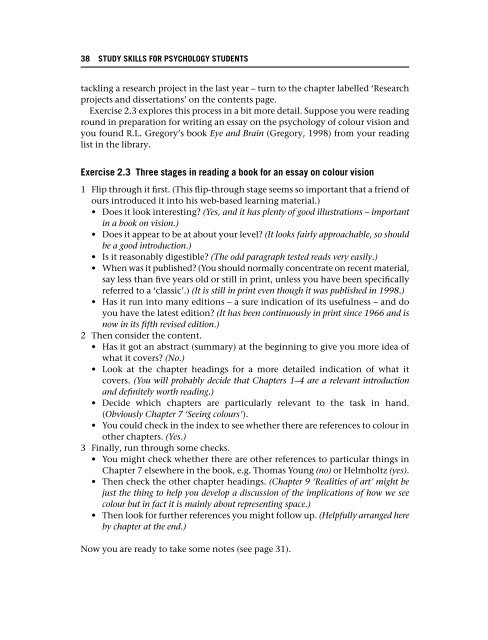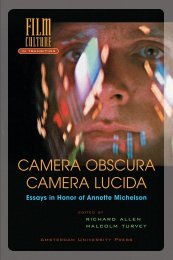Psychology - Forgot your username
Psychology - Forgot your username
Psychology - Forgot your username
You also want an ePaper? Increase the reach of your titles
YUMPU automatically turns print PDFs into web optimized ePapers that Google loves.
38 STUDY SKILLS FOR PSYCHOLOGY STUDENTS<br />
tackling a research project in the last year – turn to the chapter labelled ‘Research<br />
projects and dissertations’ on the contents page.<br />
Exercise 2.3 explores this process in a bit more detail. Suppose you were reading<br />
round in preparation for writing an essay on the psychology of colour vision and<br />
you found R.L. Gregory’s book Eye and Brain (Gregory, 1998) from <strong>your</strong> reading<br />
list in the library.<br />
Exercise 2.3 Three stages in reading a book for an essay on colour vision<br />
1 Flip through it first. (This flip-through stage seems so important that a friend of<br />
ours introduced it into his web-based learning material.)<br />
• Does it look interesting? (Yes, and it has plenty of good illustrations – important<br />
in a book on vision.)<br />
• Does it appear to be at about <strong>your</strong> level? (It looks fairly approachable, so should<br />
be a good introduction.)<br />
• Is it reasonably digestible? (The odd paragraph tested reads very easily.)<br />
• When was it published? (You should normally concentrate on recent material,<br />
say less than five years old or still in print, unless you have been specifically<br />
referred to a ‘classic’.) (It is still in print even though it was published in 1998.)<br />
• Has it run into many editions – a sure indication of its usefulness – and do<br />
you have the latest edition? (It has been continuously in print since 1966 and is<br />
now in its fifth revised edition.)<br />
2 Then consider the content.<br />
• Has it got an abstract (summary) at the beginning to give you more idea of<br />
what it covers? (No.)<br />
• Look at the chapter headings for a more detailed indication of what it<br />
covers. (You will probably decide that Chapters 1–4 are a relevant introduction<br />
and definitely worth reading.)<br />
• Decide which chapters are particularly relevant to the task in hand.<br />
(Obviously Chapter 7 ‘Seeing colours’).<br />
• You could check in the index to see whether there are references to colour in<br />
other chapters. (Yes.)<br />
3 Finally, run through some checks.<br />
• You might check whether there are other references to particular things in<br />
Chapter 7 elsewhere in the book, e.g. Thomas Young (no) or Helmholtz (yes).<br />
• Then check the other chapter headings. (Chapter 9 ‘Realities of art’ might be<br />
just the thing to help you develop a discussion of the implications of how we see<br />
colour but in fact it is mainly about representing space.)<br />
• Then look for further references you might follow up. (Helpfully arranged here<br />
by chapter at the end.)<br />
Now you are ready to take some notes (see page 31).






